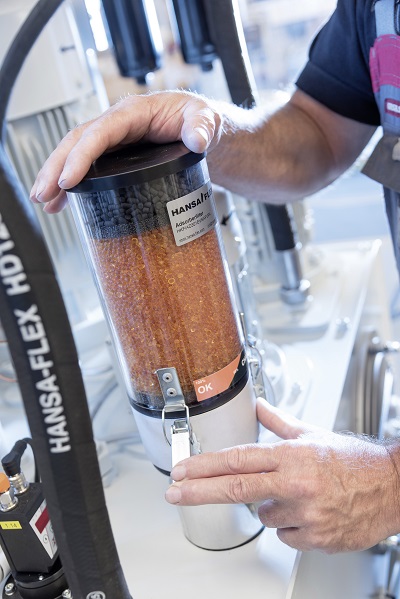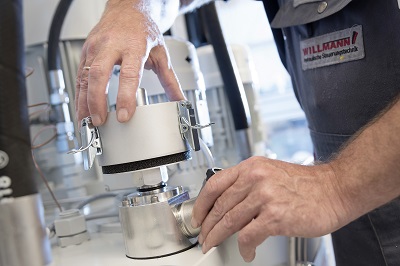Water in the oil is a serious issue for many hydraulic systems, because it can lead to increased wear and leakage. Adsorber filters which prevent moisture ingress via the tank breather system provide a remedy, according to engineers at HANSA-FLEX, Bremen, Germany.

Adsorber filters from HANSA-FLEX keep water vapor out of hydraulic tanks. Silica gel absorbs moisture and the filter changes color to indicate it has reached maximum capacity.
Unfortunately, although these filters can prevent serious damage and high costs, few systems are equipped with them. Operators often mistakenly assume that they don’t need protection against condensation, explained company officials. The fact is, if there is too much water in hydraulic oil, the system is subjected to a number of negative factors: condensation in the oil tank leads to premature aging, for example through hydrolysis. In addition, water attacks metallic surfaces and releases particles that can damage hoses and other components. Seals can also swell or shrink on contact with water and, in turn, permit leaks. Shorter maintenance intervals, high repair requirements and longer downtimes are the result.
Water can enter a hydraulic system in various ways. New oil, for example, may have a higher-than-recommended water content. Moisture can also enter the system through the rod seals of a cylinder. But what many people don’t realize is that the most common entry point is ventilation. Air can hold a sizeable amount of water vapor and it is sucked directly into the tank via the ventilation filter or breather. When the air cools, the moisture it contains condenses on tank surfaces. And because the so-called “dew point temperature” at high humidity is close to the initial temperature, even a slight drop in temperature in the tank is sufficient for condensation to form on the walls and cover. Such temperature fluctuations are a daily occurrence in some systems. The dangerous result quickly becomes visible in the form of droplets and rust.
Adsorber filters are the answer
Adsorber filters can close the access point for moisture that enters the oil via the ventilation system. They are installed on a tank and replace the conventional ventilation filter. Air is drawn in through the cylindrical adsorber filter. Any moisture is absorbed by the silica gel drying agent and bound by its dry granulate. In addition, the integrated 3 µm filter element removes all harmful particles and is the last element before air flows into the tank. The resulting relative humidity is a mere 10%. This lowers the dew point temperature to such an extent that there is no condensation in the tank even with significant temperature fluctuations.
The silica gel has another practical feature: when saturated, it changes color from orange to green — starting at the bottom of the adsorber filter. When the color changes from the top, moisture is absorbed from the inside of the tank and unit achieves effective dehumidification. If the entire adsorber filter is green, it has reached its maximum capacity and must be replaced. A regular visual inspection of the filter is therefore sufficient to ensure that it functions correctly. Adsorber filters also have the advantage that they can be retrofitted without the need to modify the hydraulic system. The work merely requires dismantling the ventilation filter and installing the adsorber filter.
Recommended applications
Adsorber filters protect hydraulic systems from condensation damage, extend maintenance intervals and reduce the risk of unplanned downtime. However, not all systems require dehumidifiers. The environmental conditions are the deciding factor: the warmer the ambient air, the more water it can absorb and then release when it cools in the hydraulic system. Wherever things get hot — for example in tire and roll-material production facilities or foundries — the risk of water damage increases.

The filters come in many versions to suit wide-ranging applications and can be retrofitted without the need to modify the hydraulic system.
The same applies to environments with high relative humidity such as lock drive mechanisms on canals, sewage treatment systems, hydraulic tanks on ships or hydraulic systems in hydroelectric power stations. This is because even small temperature fluctuations are sufficient to trigger condensation.
Regardless of relative humidity and high ambient temperature, strong temperature fluctuations present the greatest potential for damage. If a system is regularly exposed to a temperature difference of 10° C (18° F) or more, condensation will inevitably occur in the hydraulic tank. Particular care must also be taken when using organic oils. These biodegradable fluids have a strong water-attracting (hygroscopic) effect and therefore absorb humidity from the air via their surface even without condensation. The use of an adsorber filter on hydraulic tanks with organic oil is therefore highly recommended.
HANSA-FLEX offers adsorber filters to suit many different systems. These range from inexpensive disposable filters, to refillable adsorber filters with valves for long maintenance intervals, to special designs that meet ATEX 2014 specs or comply with other industry and government regulations.
The optimal solution depends on many different factors. HANSA-FLEX application engineers have, thus, developed a checklist for determining the correct adsorber filter. Numerous components are also available for mounting the filters, including flange adapters, wall brackets, adapters for the simultaneous operation of secondary filter systems and oil-droplet separators.
HANSA-FLEX
www.hansaflexusa.com
Filed Under: Sealing & Contamination Control Tips
